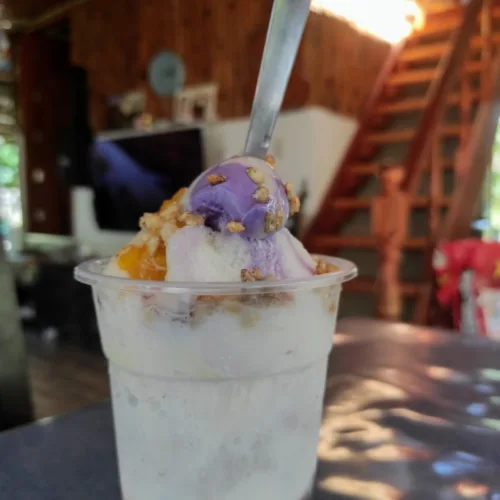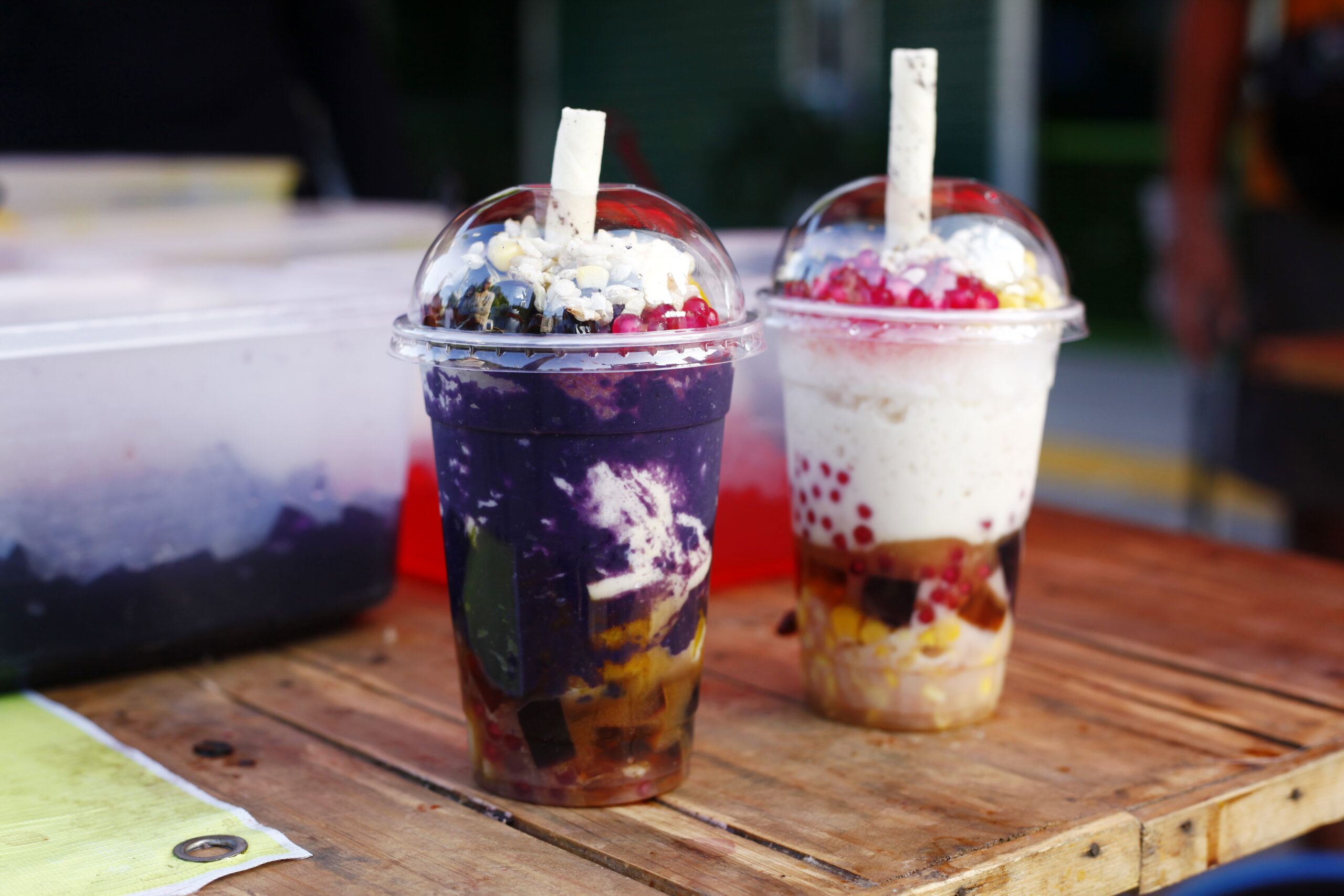“Many years later, as he faced the firing squad, Colonel Aureliano Buendía was to remember that distant afternoon when his father took him to discover ice.” That opening line from One Hundred Years of Solitude has never left me. Ice, in the tropics has always been a miracle. It is at once luxury and reprieve, a small defiance against the heat.
I knew this instinctively as a child, long before I learned its history. I spent my childhood summers eagerly waiting for halo-halo, a colorful shaved-ice concoction that is the Philippines’ quintessential hot-weather treat. I remember summers in my hometown, walking a kilometer under the blazing summer sun just for a cup of halo-halo. The heat was relentless – shimmering air over asphalt, my shirt sticking to my back – but the thought of that icy, colorful treat pulled me forward.
There was a humble stall by the church run by an old unmarried couple who knew me by name. Every Sunday after Mass, I’d scurry there, coins jingling in my pocket, to exchange my week’s allowance for a bit of cold, sweet heaven. If I had a bit more money on me, I’d splurge on the “special” halo-halo, the basic mix piled high with extras like a quivering slice of leche flan or even a precious scoop of ube ice cream on top.
Being a small barangay with people knowing each other, they’d allow me to bring home the glass with me and I’d carry my treasure back home quickly but carefully, the ice already starting to melt and trickle sticky milk down my fingers, and I’d delight in each spoonful and sharing it with my siblings, the soft banana, the gritty red beans, the chewy nata de coco, long slivers of yummy macapuno, crispy pinipig rice flakes, all swimming in cold crushed ice and creamy evaporated milk.
For regular days, they offered simpler con hielo options too – mais con hielo (corn with ice) and saba con hielo (banana plantain with ice) – but I always preferred the saba coon hielo. The bananas, cooked in syrup until glossy and golden, tasted like sunshine and sugar. Corn kernels were too plain for my child’s palate, but the plantain bananas in syrup had a rich, honeyed sweetness I couldn’t resist.

Learning to Mix and Measure
One summer, in my early teens, I decided to make and sell halo-halo myself. Perhaps I was inspired by the neighborhood kids who sold iced candy, or maybe I just wanted an excuse to have halo-halo every day. Armed with a basic hand-crank pangkaskas ice shaver and big dreams, I set up a makeshift stall in front of our house. Very quickly, I learned the pragmatics of this beloved dessert. Halo-halo requires so many ingredients – jackfruit, red beans, white beans, sweet potato, gelatin, sago pearls, macapuno strips, plantain bananas, milk, sugar – a whole rainbow and then some. On a slim budget, I had to prioritize. I knew the milk was non-negotiable: without lots of evaporated milk, a halo-halo falls flat. The bananas, too, were essential for me; their caramelized sweetness could anchor the entire flavor of the mix. Those two would be my focal ingredients (and they were relatively affordable in bulk). To fill the cups, I learned to pad the mixture with cheaper treats: colorful gulaman jelly cubes and soft sago pearls cost little but made the halo-halo look bountiful.
I didn’t always have the luxuries – macapuno or leche flan – on hand, because they were expensive to source or make. In our neighborhood, a quiet competition raged each summer among halo-halo vendors. One corner store would boast “10 ingredients!” on a hand-painted sign, then another would up the ante with “12 ingredients!” as if sheer quantity were the mark of the best halo-halo. As a young home vendor, I felt that pressure. I improvised with what I had, managing about seven or eight ingredients in my halo-halo. My mother teased that the lady down the road gave more, and I have to admit I felt envy when a neighbor managed to offer ube jam or kaong (sugar palm fruit) that I couldn’t.
Some days, when I have more time, I’d make the “faux” ube made with carefully chosen waxy sweet potatoes. But I also discovered something important: taste mattered more than numbers. Customers would return for my halo-halo not because I had the longest ingredient list, but because the balance was right, the bananas were sweet and soft, the ice was fine enough, the milk generously poured, and the overall mix just hit the spot. The lesson that quality and harmony of flavors matter over sheer variety stuck with me. It’s a lesson you learn scraping by on limited means: make the most of what you’ve got, and make it delicious. I’d retort to the teasing, “Di bale, masarap naman!”
Simplicity and the Halo-Halo of My Dreams
Years later, I encountered a version of halo-halo that perfectly embodied that “less is more” philosophy. It was at a small restaurant in the city bearing the name Razon’s, a now-famous halo-halo originating from Guagua, Pampanga. You have to try Razon’s, people said, they only use three ingredients! Three? I thought it was a joke. After all, in my childhood, we prided ourselves on cramming as many sweet bits as possible into the glass. But there it was, Razon’s halo-halo arrived looking almost austere. Instead of a vibrant jumble of colors, it was an elegant pale sundae.
But one taste and I was in love. The first spoonful was a revelation: the ice melted like cotton on my tongue, the bananas and macapuno were luxuriously soft and sweet, and the creamy milk tied it all together. Razon’s had distilled halo-halo to its essence: milk, sugar, ice, banana, coconut, flan – every component high quality and nothing extraneous.
As a former halo-halo seller who used to agonize over ingredient count, I found this both shocking and inspiring. I couldn’t help but wonder: How do they make it so good? I mused over possible secrets. Was the evaporated milk they used a special blend, or maybe they added a touch of rich carabao’s milk? Did they pre-flavor the ice itself with a bit of coconut water or milk for extra creaminess? One persistent rumor I’d heard (perhaps more imagination than fact) was that Razon’s mixed a little coconut milk into the water before freezing it, infusing the ice with subtle flavor.
Intrigued, I tried to replicate Razon’s halo-halo at home. I caramelized bananas the way I knew how, procured bottled macapuno, even made leche flan from scratch. The biggest challenge was the ice – my blender and hand-crank shaver produced ice grains that were coarse, chunky, nothing like the powdery snow from Razon’s old-fashioned ice machine. I even tried freezing coconut milk into ice cubes (that experiment was a messy failure; the fat in the coconut milk clogged up the shaver). In the end, my homemade “Razon’s style” halo-halo was good, but not quite that good. It lacked the ethereal lightness of the original. I realized then that the true secret probably wasn’t a hidden ingredient at all – it was the technique and the quality born of experience. The Razons had been making halo-halo since 1972, shaving ice to gossamer fineness and perfecting the art of balancing just a few ingredients. The lesson came full circle: the magic of halo-halo is not in how many items you mix, but how well it’s mixed and how good each element is.
Is Halo-Halo Truly Pinoy?
I’ve always assumed so. Or probably I didn’t actually think about it. But the iconic layering of halo-halo belies a complex history of cultural mixing. Despite its very Filipino name and identity, halo-halo’s story begins with an unexpected source. Food historians trace its roots to the Japanese dessert kakigōri, a shaved ice treat often topped with sweet beans and syrups. Ambeth Ocampo mentions that in the early 20th century – the 1920s and 1930s – Japanese immigrants in the Philippines began selling a simple concoction of crushed ice topped with sweetened red mung beans, which they called mongo-ya . (Mongo or monggo means mung bean in Tagalog, and indeed those beans stood in for the Japanese adzuki beans.) These Japanese-run stalls would serve a monggo con hielo – literally “mung beans with ice” – drizzled with milk and sugar for just a few centavos. It was a humble creation: a glass of ice with boiled sweet beans, sometimes a bit of caramel or evaporated milk, nothing more.
Over time, Filipinos found this sweet ice treat delightful and began to adapt it to local tastes. More ingredients were added gradually – a bit of saba banana here, some jackfruit or macapuno there – evolving the simple mongo con hielo into the multi-colored halo-halo we now know . One early variation that emerged was maíz con hielo – sweet corn kernels with ice and milk – likely inspired by the same concept (in fact, maíz con hielo is a Spanish-named cousin of halo-halo). The mais con hielo is usually topped with pinipig (rice flakes). And of course, my childhood favorite, saba con hielo, was another offshoot. I realize that these single-ingredient versions are essentially time capsules of halo-halo’s early days: even today you can still find stands offering monggo con hielo, maíz con hielo, or saba con hielo as simpler (and cheaper) alternatives..
The shift from those minimalistic ices to the flamboyant halo-halo happened as the Philippines itself modernized. The introduction of commercial ice plants at the Quinta Market in Quiapo around 1902 made ice cheap and plentiful in the tropics. By the 1920s, getting a block of ice to shave wasn’t the luxury it once was, and cold treats became more accessible \. As the availability of ice coincided with the creativity of Filipino sweet tooths, halo-halo blossomed. It became a sort of edible mirror of Philippine culture with a base of foreign origin, layered with native ingenuity.
By the mid-20th century, halo-halo was everywhere, from roadside stalls to home kitchens to hotel menus. It became so popular that it’s often called the unofficial national dessert of the Philippines . The name itself, halo-halo (mix-mix in Tagalog), invites you to stir together those diverse ingredients, a mix of magic that comes together when distinct parts come together as one.
Food writer Doreen Fernandez captured this transformation when she called halo-halo “mixed, married, merry”, an improvisatory joy with no formula, echoing Philippine life itself. For Fernandez, halo-halo was a story of cultural layering: disparate elements blended into harmony, our history and our pleasures embodied in ice and milk. That improvisatory spirit, born of both necessity and abundance, is what turned a Japanese shaved-ice stall into one of the most iconic Filipino desserts .
After the war, the Japanese “mongo-ya” shops vanished along with the Japanese , but by then halo-halo had firmly entrenched itself in the Filipino palate. Filipino vendors took over, and halo-halo became even more Filipino, incorporating local produce and homegrown custards. We indigenized the concept completely: adding leche flan (a nod to our Spanish influence), ube halaya (mashed purple yam, a truly native delight), and whatever sweet fruits or beans we had on hand. Interestingly, one key difference emerged between the Japanese kakigōri style and the Filipino halo-halo: the Japanese tended to put their sweet toppings above the ice (as a pretty garnish), whereas Filipinos buried most of the goodies under the ice, hidden like treasure to be revealed as one mixes the dessert . This reflects a bit of our playful culinary sensibility – the fun of digging in and unearthing each sweet surprise from the depths of the glass.
A Dessert of Ingenuity, Identity, and Pinoy Imagination
Clinton Palanca offers a wry observation that perfectly peels back a cultural experience: “When faced with a towering halo-halo, many foreigners eat it layer by layer… only to discover the sugary syrup at the bottom—and realize they’ve been doing it all wrong.”
No wonder halo-halo charms even those unfamiliar with it. I watched Anthony Bourdain sit on a plastic stool in Manila, marveling at halo-halo and calling it “wondrous” and “oddly beautiful,” admitting he didn’t recognize half of what was in it . In 2016, halo-halo even found its way to California’s Coachella music festival, where a Filipino-Canadian chef served a trendy version to concert-goers, mixing in novel elements like breakfast cereal and even an energy drink into the traditional base. Imagine that – our humble barrio refreshment reinvented as a vegan, neon-colored gourmet dessert in front of an international crowd. Halo-halo has truly traveled far.
Savoring Memory, Mixing in Meaning
The first crunch of ice and the rush of creamy milk inevitably carry me back to that little church-side stall in my hometown, to the sound of ‘ice kaskas” in the afternoon and the weight of coins in my hand. I’m reminded of the wide-eyed girl who would do anything for a taste of sweetness, of the teenager who learned the value of taste over flashiness by selling halo-halo one sweaty summer, and of the curious soul who sought the secret of the perfect halo-halo in a cup of Razon’s.
Writing about it now, I realize I am, as Doreen Fernandez put it, savoring the word as I once swallowed the world. A simple dessert, yet it contains multitudes: my personal history and my people’s history. The taste of evaporated milk reminds me of childhood innocence; the chunk of leche flan evokes the hands of my mother and grandmother who taught me our recipes; the bright strings of jackfruit recall the backyard trees of a tropical youth.
As I gently stir my halo-halo, watching the vivid layers swirl into a ube symphony, I feel that metaphor deeply – the way our lives, our culture, are mosaics of influences and experiences, all the better when appreciated as one. And then, I take a bite – cold, sweet, a little crunchy, a little soft. In that blissful moment, theory melts into pure sensation. It’s just me and my halo-halo tasting like summer, struggle, and sweet salvation in a glass.
Sources:
Historical origins and evolution of halo-halo; introduction of ice and Japanese influence; cultural significance and international recognition; regional and modern variations.
7 Unique HALO-HALO Versions around the Philippines | The Poor Traveler® Itinerary Blog
Japanese origins of the Philippine ‘halo-halo’ | Inquirer Opinion
Halo-halo – Wikipedia
https://en.wikipedia.org/wiki/Halo-halo
Food origins: The halo-halo’s macapuno, nata de coco and kaong and how they’re made – NOLISOLI
https://nolisoli.ph/94324/food-origins-halo-halo-macapuno-nata-de-coco-kaong-20210224/
‘Anthony Bourdain: Parts Unknown’ in Manila: Just the One-Liners | Eater

